France is the home of haute couture, of Paris fashion week, of innovation and style. It’s also the place where the humble bikini was created. So as the weather warms up and we don our bathing suits and head to the beach for summer, let’s take a look at how French swimsuits have changed over the last 150 years.
Head to toe
One of the earliest mentions of bathing costumes in France comes from the west coast of France, in Arcachon. In 1847 the mayor issued the following regulation:
‘Men bathing on the Bassin coast will be wearing large pants and will keep as far away as possible from women. They will dress up in the beach huts that surround the beach for this purpose. And should they, for any reason, undress in their houses, they will have to cover their bodies with a wool shirt or any other clothes to get to said huts. Ladies will have to bathe in a long robe that reaches their heels. It is forbidden for any swimmer of any sex to talk or make dirty moves while bathing and on the beach.
A little bit of History

‘Dirty moves’ aside, swimming as a form of recreation was a fairly recent innovation. There is evidence from thousands of years ago that people on almost every continent were swimming for health, for fun and for competition. In Europe, however, by the end of the Bronze Age it seemed they had forgotten how to swim, likely because of the Ice Age lasting 10,000 years which made swimming in freezing temperatures quite uncomfortable. This cultural aversion continued long after the weather warmed up.
In the Middle Ages they were afraid of the water, imagining giant creatures, dragons and sea monsters in its murky depths. They believed that rivers and streams had magical powers to detect wrongdoing, and that it was disrespectful to the gods for people to enter the water. Water was punishment: in the early 13th century Philip Augustus of France ordered people who blasphemed in public to be thrown into the river, and strong willed women were placed in iron cages and dunked in water to stem their vitriolic tongues. L’eau was also considered dangerous as tales abounded of unlucky Crusaders slipping and drowning in various bodies of water, their faith in God not enough to save them. The French theologian Jacques de Vitry told a moral story about drowning: a man warned his wife to stay away from the riverbank but she disobeyed and drowned in the river, and in 1572 hundreds of Protestants were forced into the Seine and drowned in the Saint Bartholomew Massacre.
In France the Catholic church had been against swimming as decadent and immoral, because clothes generally had to be removed to do it, and therefore it was associated with sex or deviant behaviour. Images of naked Tahitian and Tasmanian women swimming freely merely xx the immodesty of sea bathing, even as swimming as a scientific pursuit began to be popular in the 18th century. It was really only accessible to the wealthy, as specially designed bathing machines (in France more like changing cabins) allowed the bather to change into a loose flannel or wool robe and enter and exit the water usually without being seen. France was somewhat occupied with the French Revolution by the end of the century, but even a four year old future Napoléon III bathed at Dieppe in 1812.

Time for the Beach
As the railway lines forged their way to the coastlines of France in the mid to late 19th century, sea resorts such as Deauville in Normandy and Biarritz in Pays-Basque became places to be seen in all seasons. Before, there were very few people except the very wealthy who had the time and the money for a ‘trip to the seaside’; subsequently, the coastal regions became more a little more accessible (but not yet to all). And this is where we begin to see the first of the modern bathing costumes.
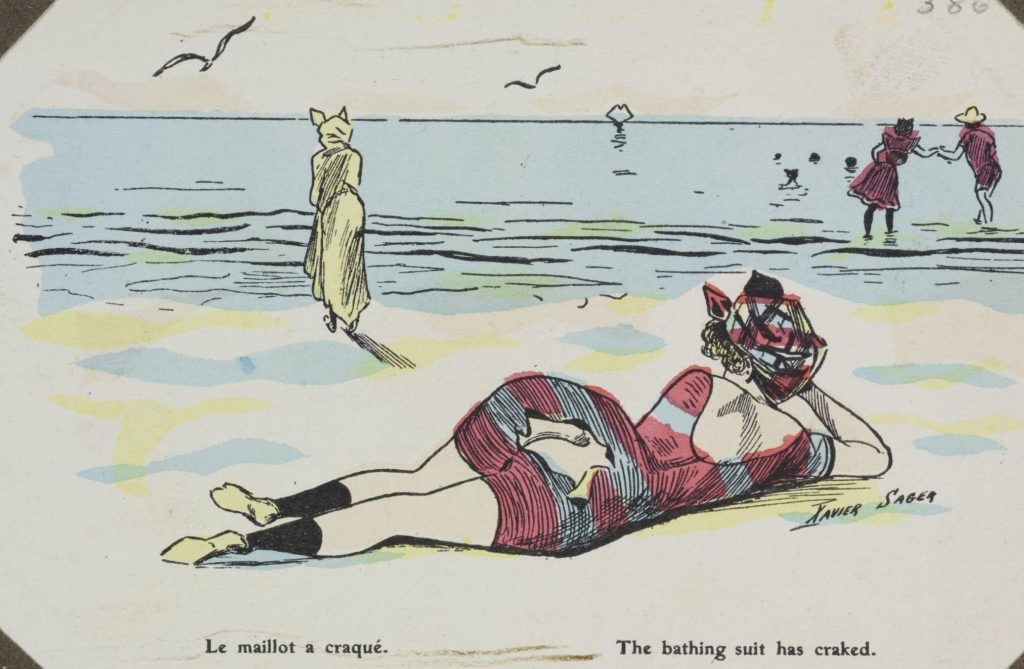
The adoption of bathing costumes was generally associated with a tendency for rich people to wear more and more underclothing. Clothing became cheaper with the introduction of commercial cotton in the early 1800s, grown by slaves in the French colonies, and spun and woven by the textile industry in the mills of Normandy, so people could afford more of it. But elaborate bathing costumes also suited the desire of the elite to disassociate themselves from the sexualised swimming of Indigenous and African people.


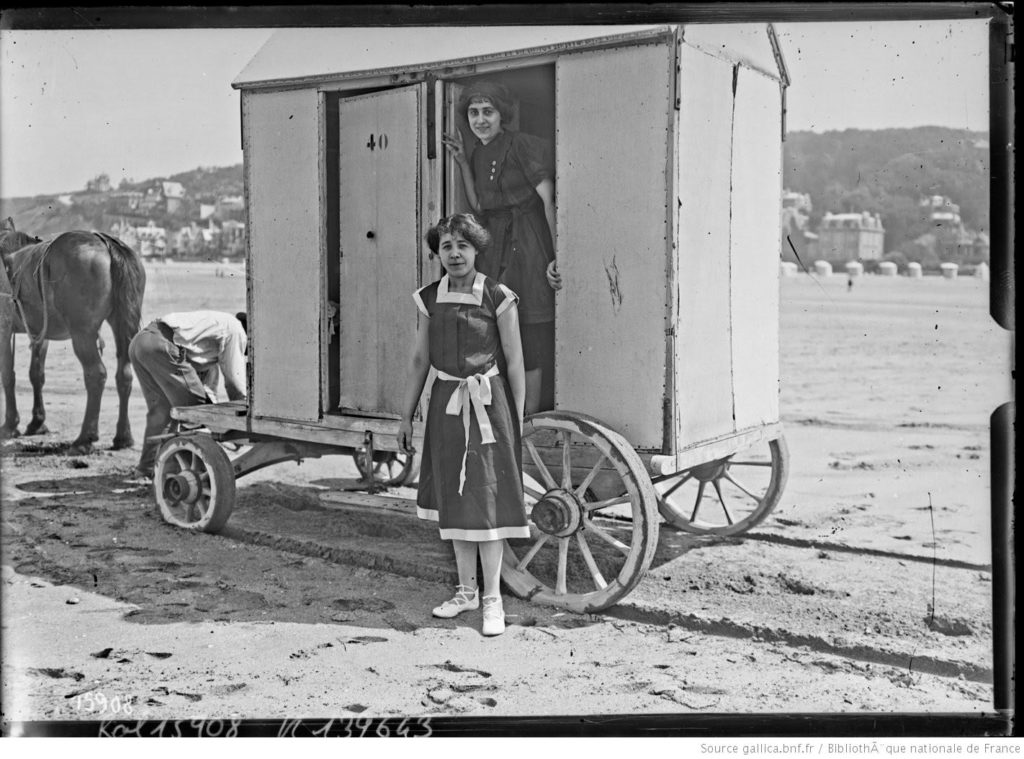
Early swimsuits for women kept much of the body covered, and were of a heavy wool fabric. Corsets and black stockings were often worn with their costumes! The style, or la mode, was very much influenced by the sailor outfit common amongst small boys of the wealthier classes.
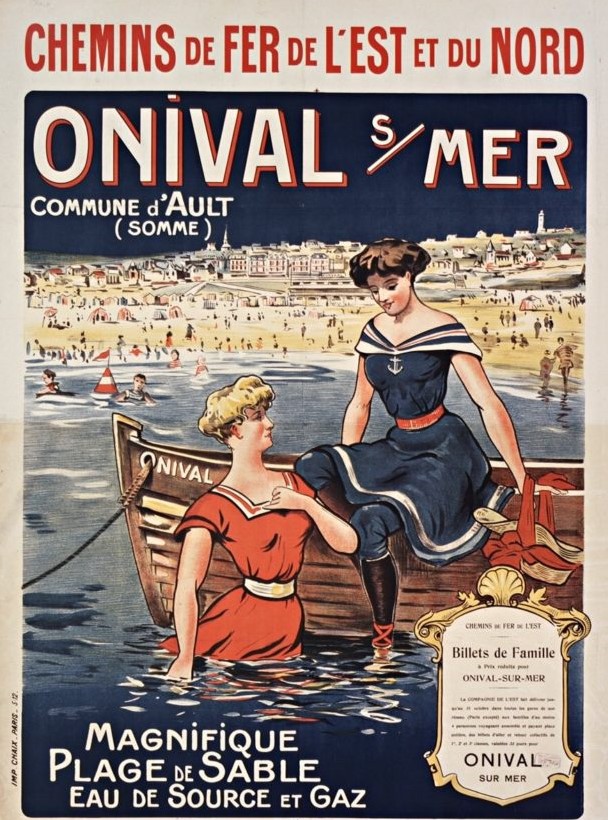
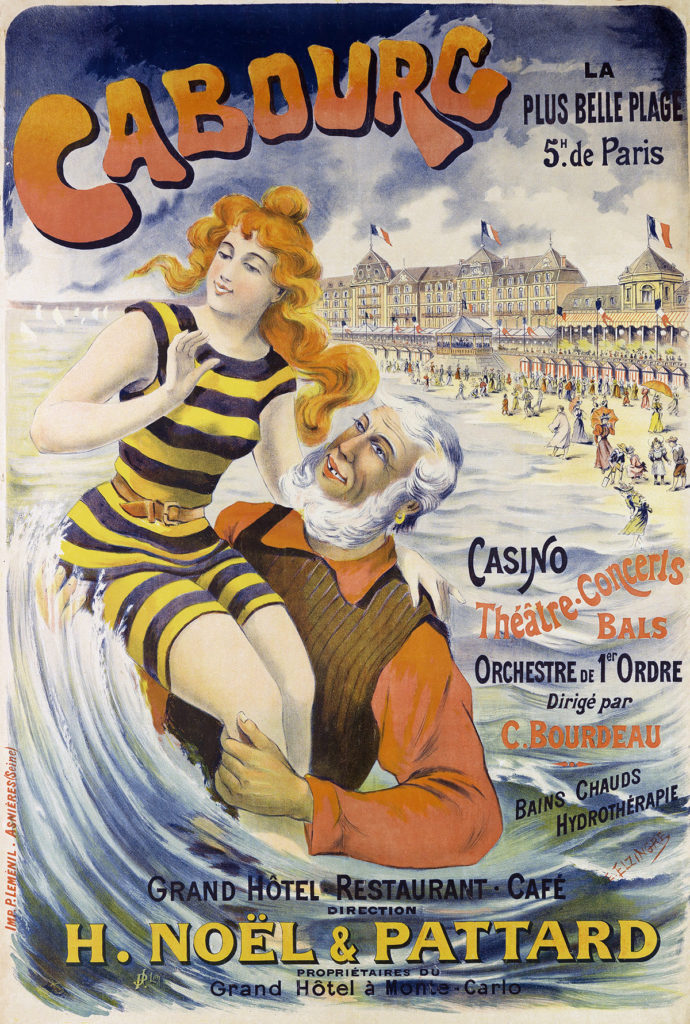
But while the colourful advertisements may have shown happy women wearing the latest in bathing costumes, it was only the bravest (and wealthiest) of women who actually wore them. Most women just donned their lightest clothes if they went swimming.
In fact, most people still did not know how to swim. In the larger beach resorts, wooden stakes were installed not far from the shore and ropes were then attached. Happy bathers were able to hold onto the ropes and float and splash to their hearts’ content. Heavy woollen outfits did not help, as wool is hardly conducive to bathing. Women were starting to reveal more of their bodies, but the fabric was still quite heavy. It was common to see stockings under the skirts and often matching breeches, which were usually attached to the waist, and shoes were necessary to hold the stockings in place.
As the beaches became a more popular destination, the female swimsuit became shorter. It was very similar to that worn by men for decades- sleeveless, exposed shoulders, knee length.

The flapper
In the 1920s, the garçonne, or flapper, made her appearance, even at the beach. Women all around the world threw away their corsets and petticoats and welcomed the sleek, straight lines of the latest fashion, which came packaged with a desire for female liberation and gender equality. On the water, the maillots de bain were sleeker and more revealing than they had ever been in the history of swimsuits.
The point of swimsuits at that time was to be seen in them –not so much for bathing.
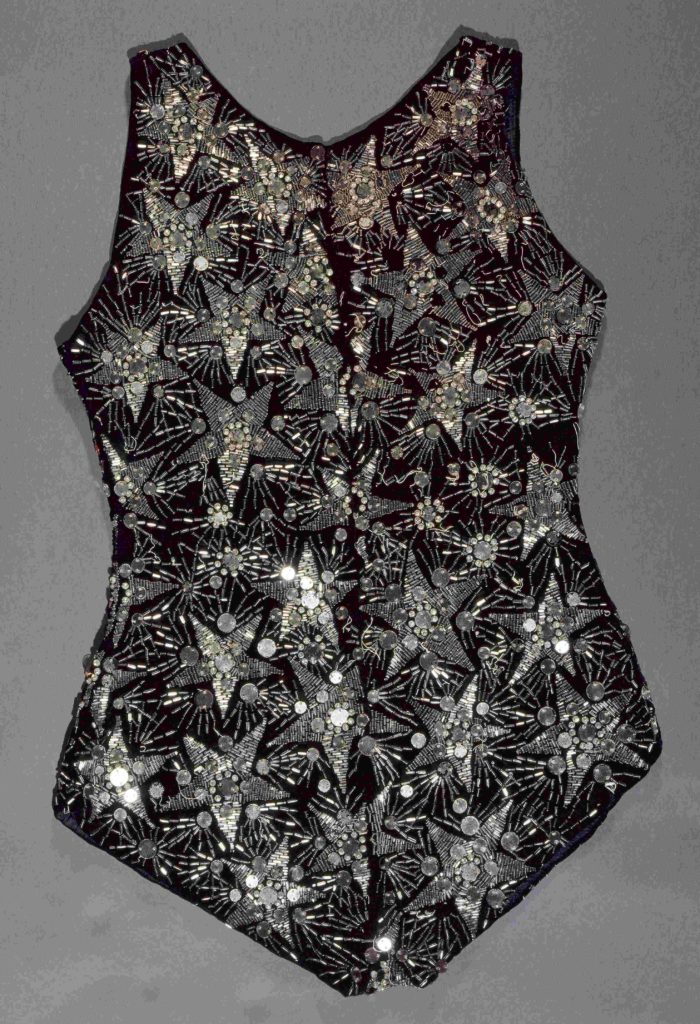
It is fashionable to be seen in Deauville and the most unsettling fancy there is probably the choice of swimsuits –which do not implicate at all to go bathing in them. Some suits are ravishing and very expansive and it would be unwise to risk facing waves wearing them. These are designed for the beach bars, not for swimming.
l’Officiel de la mode, 1926



Generally, the flappers at the seaside resorts were wealthy and needed to be seen at all the chic plages like Deauville, Le Touquet and Biarritz.
As the swimsuit became shorter, more of the body was also exposed to the sun. Prior to this a tanned complexion was considered very working class; a ‘lady’ was noticeable because of her white and unblemished skin. It is generally believed that the trend towards a suntan started in the 1920s when Coco Chanel returned from a holiday in 1923 with a bronzed complexion, but this is not exactly true; it had been growing for some time in the decades beforehand. But Chanel and other trendsetters certainly helped a tan become a fashion accessory in its own right.
Chanel also took her famous jersey to the seaside, working with lingerie-weight jersey knits to create a new style which was not only sleeker, but a lot more comfortable. Knitted and stretchy swimsuits were soon mass-produced by American company Jantzen in the 1920s.
The race is on

However, swimming as a sport was beginning to become popular, and so suitable outfits were necessary. Australian champion swimmer Annette Kellerman shocked the world when she was supposedly arrested on Revere beach in a tight fitting neck to knee costume, but how could she possibly attempt to swim the English Channel in a woollen dress? Unfortunately her three attempts from 1905 were unsuccessful. More successful was American Gertrude Ederle who became the first woman to swim between Cape Gris Nez and Dover in 1926 breaking several world records in the process. And wearing a one piece swimsuit.
By the 1924 Olympics held in Paris, women competitors were wearing simple one pieces showing their arms and legs.

By 1927, the Riviera had overtaken Deauville and Biarritz as the place to go, and swimsuits were sold in the boutiques of Chanel, Elsa Schiaparelli, and Jeanne Lanvin.


Related post: When women ruled the world of fashion, maisons de couture of the Belle Époque
Related post: Riding the Blue Train to Nice
We’re all going on a summer holiday!
The 1930s saw enormous social changes in France. Two million workers went on strike in May 1936 for better working conditions, and a month later a law was passed allowing ecstatic workers 15 days of paid holidays.

And so to the beach they flocked, in their thousands. Railway companies competed with each other by offering cheap train tickets; 800,000 people travelled to the coast in 1937. Those who could not afford the cost of a train ticket walked or pedaled their way to the beach.

However, unfortunately for the beach-loving people of France, the paid summer holiday did not last more than a couple of years, as economic hardships and World War II intervened.
The German army occupied France in 1940 so leisure time by a heavily fortified coastline was not possible until the second half of the 1940s. Swimwear soon became an industry, and the costumes more revealing. Partly this was to do with rationing – smaller swimsuit, less fabric, but it also came from the development of new materials such as Lastex, a stretchy yarn made from latex rubber. Wartime technologies and developments meant an increase in artificial materials like spandex and colourful prints saw a greater range of maillots de bain than ever before.
Itsy Bitsy Teeny Weeny
The post-war 1940s bought with it a revolution in the history of the swimsuit. Two-piece swimsuits had been seen in the previous decade, but none had ever exposed the navel. Until now.
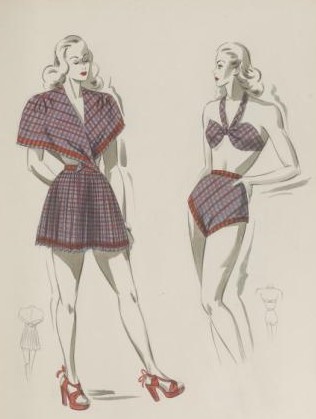
Louis Réard was a designer and promoter of a popular beauty and swimwear contest called La Fête de l’Eau, held annually at the Molitor Pool in Paris. Réard had created quite the scandalous two-piece swimming costume for his show in 1946, but had yet to decide on a name.
Luckily for Réard, the US dropped an atomic bomb on the Bikini Atoll in the Pacific Ocean just days before his show, and in a lightbulb moment he had the perfect name for his tiny creation: the bikini. None of the contestants, however, would wear such a revealing outfit. Instead, a nude dancer from the Casion de Paris, Micheline Bernadini, was chosen to drop the bikini bomb during the competition by wearing, by the standards of the day, not much at all. her bikini was so small it could fit into a matchbox and was printed in a newspaper pattern.


The first bikini proved too revealing for almost everyone, and it was banned from the Miss World contest in 1951 after Miss Sweden was crowned wearing something quite itsy bitsy. It was not until a little later in the the 1950s that the two piece bathing suit became popular.

In the mid century, new fabrics such as nylon also allowed for tighter but stretchier costumes.

Film stars, with their sexy and powerful hourglass figures, revealed the latest swimsuits to the world. In 1953 Bridget Bardot starred in the French film Manina: la femme sans voiles, (released in the US in 1958 with the title Manina: the girl in the bikini). The film was fairly controversial as the actress Bardot wore several tiny bikinis, racy even for France.
A return to elegance

In 1955, Christian Dior entered the world of swimsuit design for the first time when he was persuaded to create a line of bathing costumes for Cole of California.
They are not too bare and yet show off the feminine figure to the best advantage in the Dior romantic manner…. when telling us about his line of line of beachsuits, he added: “The body should have a fomr, be well built, and have line, like the simple dresses I like to design and make”
International Herald Tribune, 1 December 1955
Women everywhere wanted the structured, tight waisted bathing costumes, which usually came with matching shirts, skirts or pants – the birth of resortwear. A modern woman could spend her afternoon lounging on the beach and afterwards mingle at a fashionable cocktail bar, all without a change of clothing.

Day to Evening ensemble by Jacques Fath, 1946, maillot de bain with blouse and skirt, image from Paris Musées collection.
women in rebellion
But as the 1960s started swinging, and bras were burnt, tailored underwear and tight girdles lay abandoned and comfort was the new direction for swimsuits. Lycra was the new fabric, much stretchier and form fitting, but definitely more comfortable than itchy wool. While in the US there was a trend towards more coverage, in France Bardot’s bikinis sparked a trend for gorgeous fabrics in fabulous colours, and a lot more skin on display. On the beaches in the south of France, women did away with tops altogether and the Riviera was awash with tanned and topless sunbathers.
In the seventies, swimsuits shrank. Bikinis were four triangles and two pieces of string, or even three triangles if you chose to wear a thong. Glamourous cut-away costumes were in, using stretchy, shiny nylons and in all conceivable colours. No more matching designer shoes, dresses and scarves; the jet-setters on the Med simply threw on a kaftan over their swimwear, if they wore swimwear at all. Tans were compulsory, so the smell of coconut oil pervaded the beaches and left a greasy film in swimming pools and stains on swimsuits.
Since the 1980s, swimsuits have become big business for French designers such as Chanel, who add more than a touch of luxury to their mailots de bain.

Fifty years ago, there were some designers who predicted full beach nudity would be the norm within several decades. Thankfully this has not come to pass, and we enjoy an enormous range of bikini and maillot style swimsuits right now, looking both to the past and to the future for inspiration.
References
Karen Eva Carr, Shifting Currents : A World History of Swimming, Reaktion Books, Limited, 2022.
Sarah Kennedy, The Swimsuit: A history of twentieth century fashions, Carlton Books, London, 2007.



